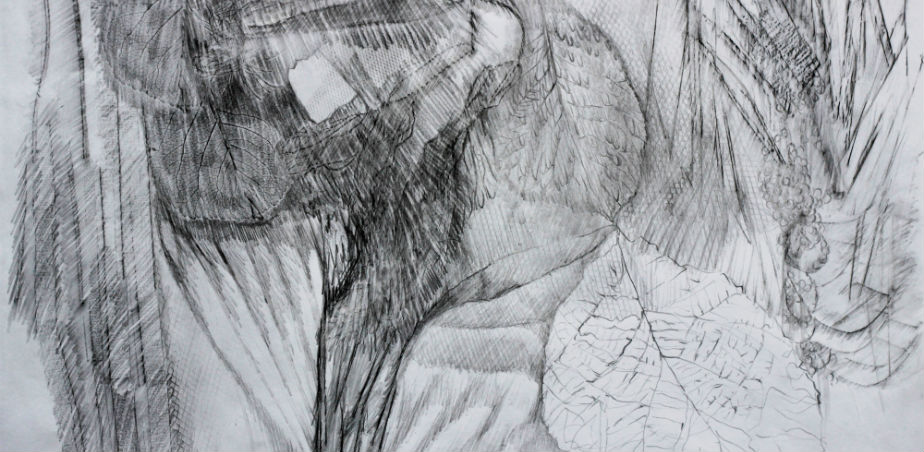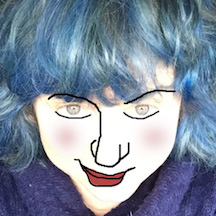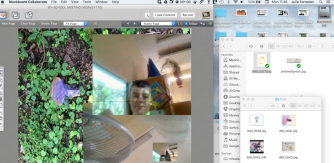Blog 4 – Julie Forrester, Visual Artist

Mixed Ecology copyright Julie Forrester

Julie Forrester is a visual artist based in Cork City. She has been working with all kinds of people in all kinds of settings since her return to Ireland in the 1990s. Her work celebrates process and open ended enquiry into materials and context. Julie Forrester is currently in residence with Kidsown Publishing Partnership at Killard School, Co Down.
Blog 4
In my final blog I would like to describe my response to an invitation to lead a workshop.
I have been asked to focus on the interaction between the identities of maker and educator…
– exciting!
and to begin by submitting a 50 word blurb for the workshop
– challenging!
Settling in to task I find that I am a little ill at ease with the label, educator. Learning in arts practice comes about from the creative encounter, and the excitement of discovery, we all know that even when a ‘discovery’ has been made a thousand times before by others our own personal experience is the vital thing. So, by setting a path and then looking for traces, following these and generating some excitement about where they might lead, I feel more like a Companion tracker than ‘educator’: we find our own routes of discovery in the world about us.
The richness of arts practice means that discoveries may be found in just about anything: the way a particular material behaves, or by becoming aware of a new sensitivity to sound or colour, or in the places a mind might wander while creating a rhythm with a lump of charcoal. And in the education setting, where there is a wealth and breadth of experience, sharing these discoveries with others is a particular pleasure which doesn’t happen in the studio.
Often in the education setting a theme is superimposed onto the art process, this theme might be drawn from with the school curriculum. So for example one might begin with a broad parameter called “Ecology.” We look for a jumping off point and so we may begin by a brainstorming activity – perhaps the naming of all of the plants we know, then perhaps by making a collection of indigenous species of plants – the way one might approach the creation of this collection is diverse and this approach will often set the methodology for the project.
MAKER
When I am alone, in studio I have my radio tuned, usually to Lyric FM, it may be day or night, music and light discretely setting mood and contributing to context. The starting point for work is incidental to me, and the farther it is from any kind of reasoning, or logic, the better. The first mark in the void, needs to be unattached, innocent. Throw up a coin and watch it land. After that there is something to respond to. This initial mark is like a lodestone attracting whatever is buzzing in the air, it expands the possibilities of the moment.
Work becomes a series of acts, of making and responding of adjusting and reinterpreting, slipped in with memory and carried out with a heightened sensitivity to coincidence and connection. The work evolves, parts are discarded, parts are advanced, the whole becoming gradually orchestrated into some edited, arrived at, Thing/Series of Things. If this all sounds rather vague perhaps it is in this part, a conjuring; a cloud of energy seeking form. A theme will arise midway through a project, the beginnings are tentative, arbitrary and blind. The way is felt.
(EDUCATOR)//TRACKER
One of the privileges of working in education settings is to be working with the curiosity of young collaborators. Collaborators, in addition to being creators in their own right, contribute much to my practice, becoming part mirror, part joker and part external eye on process. It is this working in tandem that allows flow and mutual enrichment between my practice and the project’s unfolding. Feeling my own way in the dark I am able to see more clearly what others do with the same criteria, what gets thrown up: Whatever the seekers find, and how they communicate their findings will lead us deeper into the project, and into the next phase. It is in the observation of this process that reflection becomes a driving force.
I try to encourage a commentary from participants. The voicing of observations aired during the making process are witness to a wider sensibility. When a maker becomes commentator on the work both commentator and audience are led into an observational position that opens up a reflective dimension. Process becomes foregrounded, motivations become more clear, particular sensitivities and attractions are voiced and often more subtle and unusual connections are made between image, outcome and intention.
A drawing of a dandelion might lead to a conversation about yellow, or sunshine, first experiences of the bitter sap staining hands, folkloric warnings about bed wetting or other knowledge latent within the imaginations of a group of participants. A conversation about a dandelion may begin with its name – what a strange name this flower has! We might research and find that the name is middle English and comes from French dent-de-lion, meaning ‘lion’s tooth’ that’s another image straight away. Discussions might find other routes, the gardener’s phrase that “a weed is a plant out of place” may throw up extended conversations about migration and belonging. We could think of dandelion seasons, perhaps about how a dandelion might support an ecology. An observational drawing of a dandelion before such a discursive process will be very different from a drawing from the imagination, made after these wanderings (and this is just me thinking aloud).
By recording this commentary we deepen and extend the reflective process. The recording of those observations involves an echoing and a a translation, from an initial drawing, to spoken word to written report, photograph or other kind of document. The choice of media for documentation influences this enquiry. It’s fun to play with different recording methods. …the pressing of the flower, the crushing and collection of sap, the particular material properties and behaviours of dandelion seed heads, stories about dandelion experiences, the folklore of a dandelion, actions with a dandelion.
Translation from one media to another will involve further images, references, words, actions or sounds, and will also throw up different kinds of problems, seeking creative solutions, all of which will augment and colour the work leading it on to new places. Curiosity will drive this process along. I try to remember the voice, I scribble things down on scraps of paper, transferring them later to a notebook. I find that multiple translations help my process, a hasty scribble is wildly different from a concentrated drawing out of an idea, but each has their own qualities. I use notebooks for ideas that I might try out in studio and I use blogging as a kind of scrapbook for documentation and references to other realms, a blog post might include a bit of research arising from the work in progress, it may be a fragment of video, a link to another artist’s work, something I am reading about, a piece of music, or a random image or connection found online.
Blogging is a perfect space for holding these observations and documenting the process. It is a shared space. Maker, student and teacher can refer to the observations held in the blog, an audio visual record of the territory, a map.
I arrive at my wording for the blurb:
WORKSHOP
The idea is a spark – the spark can be as volatile or as contained as you decide. There will be some parameters which will guide the explorations. Shared knowledge is rich, we will tap into this. The imagination is wild and we will allow this to roam. Other peoples’ ideas are always interesting. Roaming between our own perception, responses to peer work and free expression we will explore the territory together. (71 words)


